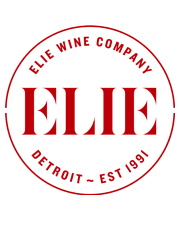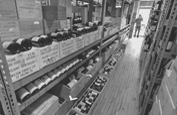The Metamorphosis of Burgundian Premier Cru: Savigny-lès-Beaune ‘Les Narbantons’ in Six Acts Spanning a Quarter of a Century (6-Bottle Pack $499)
It’s a rare treat for Elie Wine Company to offer such a depth of excellent vintages from a single producer. A gustatory exploration of these selections bears witness to the evolution of a specific Burgundian house style, a changing climate, and perhaps most fascinating of all, the sensory profile that a single variety—Pinot Noir—develops as a kaleidoscope of tertiary flavors and scents develop with bottle age.
Provenance is guaranteed for these wines, of course, so you know that storage conditions have been optimal.
|
|
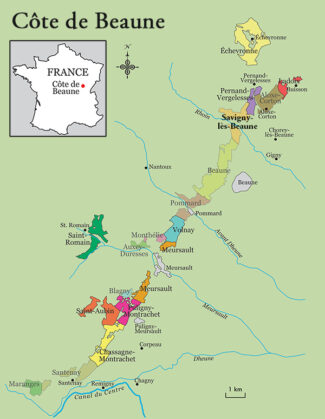
|
|
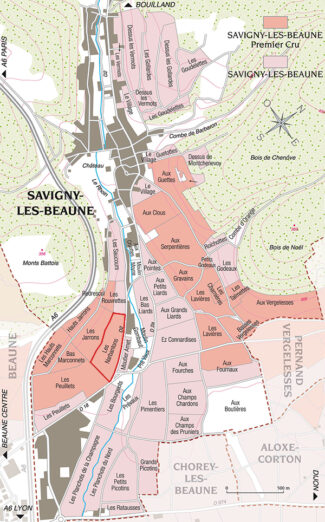
|
|
|
|
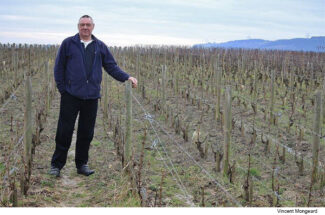
|
|
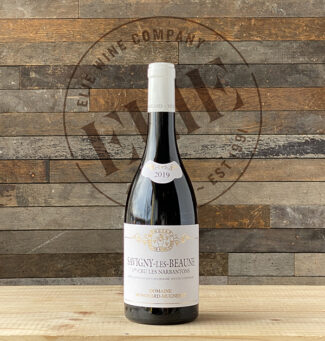 2019 Domaine Mongeard-Mugneret Savigny-lès-Beaune Premier Cru Les Narbantons ($68): From their 6-acre parcel in Les Narbantons, Vincent Mongeard drew from vines more than a half century old, hand harvesting and sorting the grapes, then aging the wine in 30% new oak. The wine shows a deep and complex bouquet of cassis, fresh wild berries, wood smoke, cola with some hazelnuts and citrus rind. A muscular mouthful, it’s layered with powdery tannins, lively acids and a long, sapid finish.
2019 Domaine Mongeard-Mugneret Savigny-lès-Beaune Premier Cru Les Narbantons ($68): From their 6-acre parcel in Les Narbantons, Vincent Mongeard drew from vines more than a half century old, hand harvesting and sorting the grapes, then aging the wine in 30% new oak. The wine shows a deep and complex bouquet of cassis, fresh wild berries, wood smoke, cola with some hazelnuts and citrus rind. A muscular mouthful, it’s layered with powdery tannins, lively acids and a long, sapid finish.
 2019 Domaine Mongeard-Mugneret Savigny-lès-Beaune ($55): 1.5 acres parcel planted to vines with an average age of 36 years, the wine sees around 15% new oak. Youthful and intense, this brilliant ruby-colored Pinot displays characteristic aromas of spice and violet mingled with wild blackberry; nice length and elegance.
2019 Domaine Mongeard-Mugneret Savigny-lès-Beaune ($55): 1.5 acres parcel planted to vines with an average age of 36 years, the wine sees around 15% new oak. Youthful and intense, this brilliant ruby-colored Pinot displays characteristic aromas of spice and violet mingled with wild blackberry; nice length and elegance.
|
|
 2017 Domaine Mongeard-Mugneret Savigny-lès-Beaune Premier Cru Les Narbantons ($84): Once destemmed, the grape bunches were crushed, macerated cold for a week, fermented in stainless steel before being aged in French oak (1/3 new) for 18 months, then bottled unfiltered. The wine’s vivid red still shows through the brick-tones, and the firm tannic structure that has now become integrated with the dark fruit notes.
2017 Domaine Mongeard-Mugneret Savigny-lès-Beaune Premier Cru Les Narbantons ($84): Once destemmed, the grape bunches were crushed, macerated cold for a week, fermented in stainless steel before being aged in French oak (1/3 new) for 18 months, then bottled unfiltered. The wine’s vivid red still shows through the brick-tones, and the firm tannic structure that has now become integrated with the dark fruit notes.
|
|
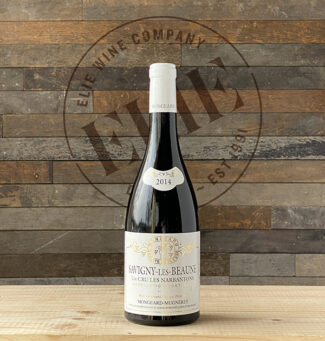 2014 Domaine Mongeard-Mugneret Savigny-lès-Beaune Premier Cru Les Narbantons ($84): The 2014 Savigny-lès-Beaune Narbantons comes from 53-year-old vines and is matured in 30% to 40% new oak. With enough time under its belt to reveal the nuanced layers beneath its primary fruit and tannin, body and grip, mushroom notes and meat stock aromas have begun to appear and for the oak tannins to integrate more completely into the wine’s fleshy body.
2014 Domaine Mongeard-Mugneret Savigny-lès-Beaune Premier Cru Les Narbantons ($84): The 2014 Savigny-lès-Beaune Narbantons comes from 53-year-old vines and is matured in 30% to 40% new oak. With enough time under its belt to reveal the nuanced layers beneath its primary fruit and tannin, body and grip, mushroom notes and meat stock aromas have begun to appear and for the oak tannins to integrate more completely into the wine’s fleshy body.
|
|
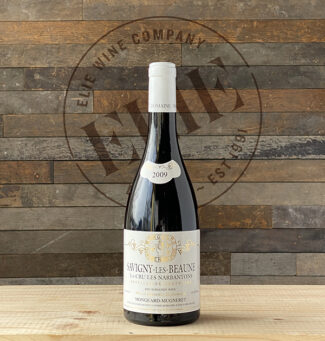 2009 Domaine Mongeard-Mugneret Savigny-lès-Beaune Premier Cru Les Narbantons ($109): Morello cherry and cranberry linger behind dry potpourri with hints of spice and tertiary notes of earth, tobacco, and forest floor.
2009 Domaine Mongeard-Mugneret Savigny-lès-Beaune Premier Cru Les Narbantons ($109): Morello cherry and cranberry linger behind dry potpourri with hints of spice and tertiary notes of earth, tobacco, and forest floor.
|
|
|
|
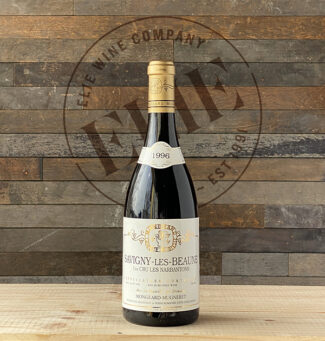 1996 Domaine Mongeard-Mugneret Savigny-lès-Beaune Premier Cru Les Narbantons ($99) Well within the drinking window of a well-made 1er Cru, the wine is beyond the angular period that may occur in Burgundies between seven and 12 years in bottle. Whether it is at the pinnacle of its potential remains to be seen, but the wine currently displays beautiful rim-bricking and aromas of black cherry, leather, brewed tea and underbrush. The mid-palate is expansive, with soft tannins and sparks of juicy acidity.
1996 Domaine Mongeard-Mugneret Savigny-lès-Beaune Premier Cru Les Narbantons ($99) Well within the drinking window of a well-made 1er Cru, the wine is beyond the angular period that may occur in Burgundies between seven and 12 years in bottle. Whether it is at the pinnacle of its potential remains to be seen, but the wine currently displays beautiful rim-bricking and aromas of black cherry, leather, brewed tea and underbrush. The mid-palate is expansive, with soft tannins and sparks of juicy acidity.
|
|
Régionales
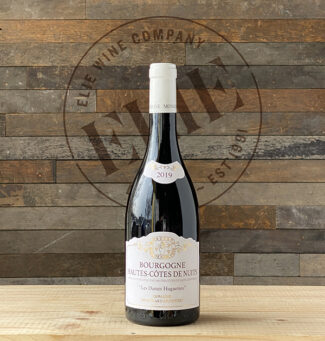 Bourgogne Hautes-Côtes de Nuits ‘Les Dames Huguettes’ ($42)
Bourgogne Hautes-Côtes de Nuits ‘Les Dames Huguettes’ ($42)
click on image for more info
click on image for more info
Villages
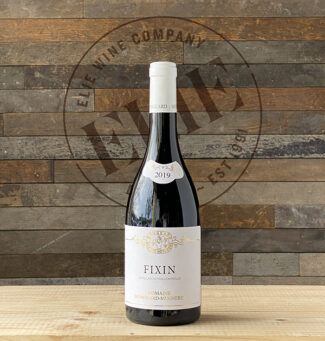 Fixin ($52)
Fixin ($52)
(2014) Fixin ($67), in stock
click on image for more info
 Fixin ‘Vieille Vigne’ ($64)
Fixin ‘Vieille Vigne’ ($64)
(2017) Fixin ‘Vieille Vigne’ ($80), in stock
click on image for more info
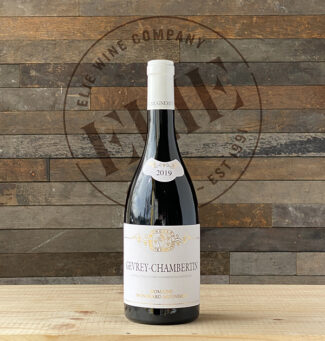 Gevrey-Chambertin ($74)
Gevrey-Chambertin ($74)
(1996) Gevrey-Chambertin ($145), in stock
click on image for more info
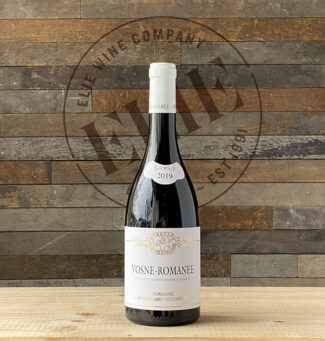 Vosne-Romanée ($74)
Vosne-Romanée ($74)
(2017) Vosne-Romanée ($99), in stock
(2014) Vosne-Romanée Premier Cru Les Orveaux ($180), in stock
click on image for more info
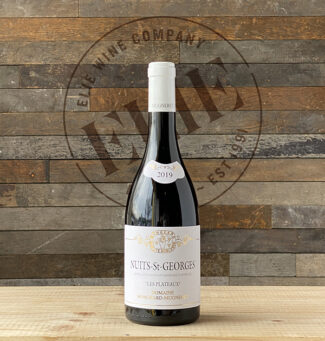 Nuits-Saint-Georges ‘Les Plateaux’ ($72)
Nuits-Saint-Georges ‘Les Plateaux’ ($72)
(2014) Nuits-Saint-Georges ‘Les Plateaux’ ($97), in stock
(2017) Nuits-Saint-Georges Premier Cru Les Boudots ($135), in stock
(2003) Nuits-Saint-Georges Premier Cru Les Boudots ($246), in stock
(1996) Nuits-Saint-Georges Premier Cru Aux Boudots ($198), in stock
click on image for more info
Premiers Crus
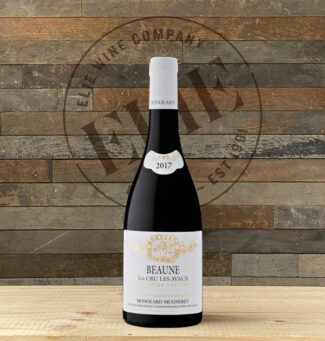 Beaune Premier Cru Les Avaux ($76)
Beaune Premier Cru Les Avaux ($76)
click on image for more info
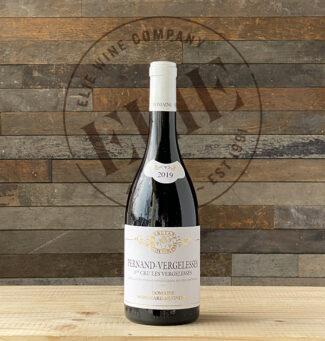 Pernand-Vergelesses Premier Cru Les Vergelesses ($76)
Pernand-Vergelesses Premier Cru Les Vergelesses ($76)
click on image for more info
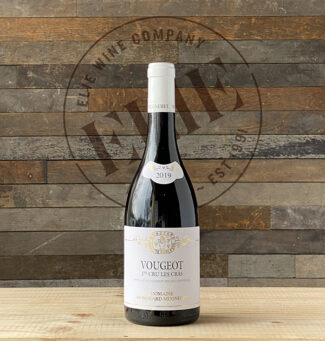 Vougeot Premier Cru Les Cras ($104)
Vougeot Premier Cru Les Cras ($104)
(2017) Vougeot Premier Cru Les Cras ($144), in stock
(2003) Vougeot Premier Cru Les Cras ($220), in stock
click on image for more info
Grands Crus
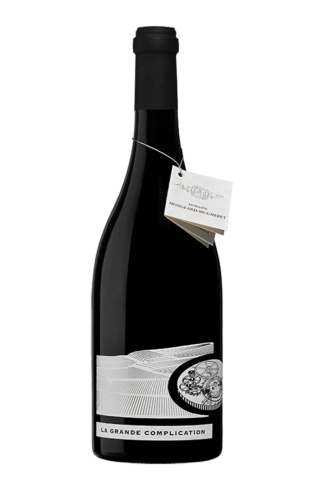 Échezeaux Grand Cru ‘La Grande Complication’ ($256)
Échezeaux Grand Cru ‘La Grande Complication’ ($256)
(2017) Échezeaux Grand Cru ‘La Grande Complication’ ($351), in stock
(2017) Échezeaux Grand Cru ($287), in stock
(2014) Échezeaux Grand Cru ($250), in stock
click on image for more info
 Grands Échezeaux Grand Cru ($256)
Grands Échezeaux Grand Cru ($256)
(2014) Grands Échezeaux Grand Cru ($290), in stock
(2009) Grands Échezeaux Grand Cru ($390), in stock
(2003) Grands Échezeauz Grand Cru ($450), in stock
click on image for more info
 Clos Vougeot Grand Cru ($224)
Clos Vougeot Grand Cru ($224)
(2017) Clos Vougeot Grand Cru ($243), in stock
(2009) Clos Vougeot Grand Cru ($377), in stock
(2003) Clos Vougeot Grand Cru ($445), in stock
(1996) Clos Vougeot Grand Cru ($445), in stock
click on image for more info
- - -
Posted on 2022.02.28 in Côte de Beaune, Savigny-lès-Beaune, France, Burgundy, Wine-Aid Packages | Read more...
The Savoir-Faire of Six Prominent Bordeaux Châteaux Applied in Castillon: Proximity and Similarity to Saint-Émilion’s Terroir Beckons (12-Bottle Pack $338)
As Diogenes went off with his lantern to look for an honest man, at Elie Wine Company, we take special pride in illuminating lesser known French and Spanish wine regions and spotlighting passionate winemakers who often fly beneath the global radar. As a result, their wines tend to be priced far below their actual worth. They are honest wines with interesting backstories, fascinating personal histories and the likelihood of bright futures.
Diogenes never found his man, but this week’s selection is just a small sample of what our lantern has uncovered.
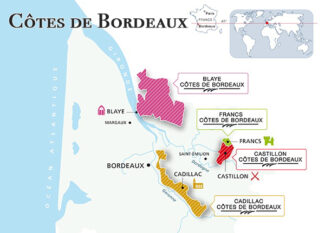
|
|

|
|
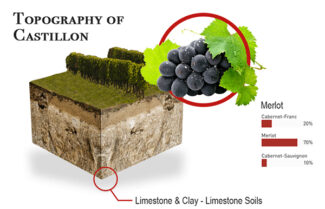
|
|
|
|
|
|
|
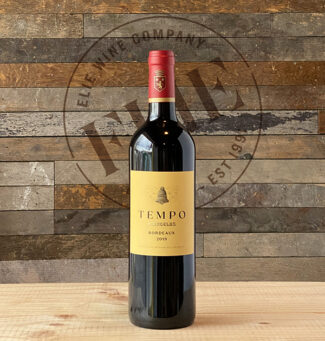 Tempo d’Angélus 2019, Bordeaux ($31)
Tempo d’Angélus 2019, Bordeaux ($31)
The 2019 Tempo d’Angélus is composed of 90% Merlot and 10% Cabernet Franc, and is an exuberant wine from every perspective. Deep garnet-purple in color, offers it blackcurrant jam on the nose, and is filled with perfumed spice notes of sandalwood and cedar with rich chocolate and smoky minerality.
|
|
|
|
 L’Hêtre 2018, Castillon – Côtes de Bordeaux ($34)
L’Hêtre 2018, Castillon – Côtes de Bordeaux ($34)
L’Hêtre’s third vintage, with harvest completed on 11 October, is 95% Merlot and 5% Cabernet Franc, and shows a rich depth of Damson plum, cherry compote, licorice and kirsch; the tension is lively and the tannins are finely-grained crushed velvet.
|
|
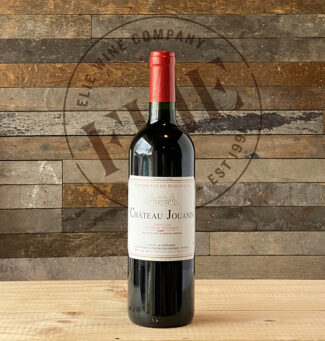 Château Jouanin 2018, Castillon – Côtes de Bordeaux ($13)
Château Jouanin 2018, Castillon – Côtes de Bordeaux ($13)
90% Merlot and 10% Cabernet Franc, the wine is seductive and powerful with fleshy fruit in the foreground and a bouquet of cassis, eucalyptus on the nose and a kick of spice. The lushness of the blackberry gives the wine a wonderful opulence and provides a cushion that allows the wine’s acidity and tannins to balance.
|
|
|
|
 Château Montlandrie 2016, Castillon – Côtes de Bordeaux ($33)
Château Montlandrie 2016, Castillon – Côtes de Bordeaux ($33)
2016 was the first vintage that Montlandrie fully barrel-aged their wine, using 40% new oak. As in previous vintages, though, it is vinified in 15 small, temperature-controlled stainless vats (one per vineyard parcel) ranging in size from 24 hectoliters to 82 hectoliters; malolactic fermentation takes place in these vats.
Montlandrie’s vineyards are 65% Merlot and 20% Cabernet Franc and 15% Cabernet Sauvignon, and the cuvées are similar; 2016 has all the hallmarks of the spectacular vintage, medium-bodied and chewy with spicy plum framed by earthy smoke and cinnamon notes.
|
|
 Château Joanin Bécot 2016, Castillon – Côtes de Bordeaux ($36)
Château Joanin Bécot 2016, Castillon – Côtes de Bordeaux ($36)
An opulent champion for the limestone soils of the Côtes de Castillon, the wine is 80% Merlot and 20% Cabernet Franc, aged on the lees in 65% new and 35% year-old oak for 15 months. The result is an open-knit scents of exotic spices—star anise, fenugreek and cumin—over a core of plum preserves, baked cherries and blueberry compote with touches of dark chocolate and chalky minerality.
|
|
 Château de Pitray 2016, Castillon – Côtes de Bordeaux ($22)
Château de Pitray 2016, Castillon – Côtes de Bordeaux ($22)
75% Merlot, 23% Cabernet Franc, 3% Malbec: The Cabernet Franc is assertive here, with slight green pepper notes rounding out the blackberry pie brought by the Merlot. Additional flavors of mulberry and hints of spice cake, aniseed and tobacco. There is a lovely freshness and an approachable, soft texture that frames the fruit, finishing long and savory. 6000 cases produced.
Add one bottle of the following wine for a baker’s dozen at $380.
|
|
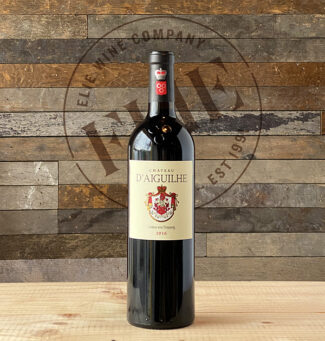 Château D’Aiguilhe 2016, Castillon – Côtes de Bordeaux ($42)
Château D’Aiguilhe 2016, Castillon – Côtes de Bordeaux ($42)
A core of blueberry, blackberry and ripe Morello cherry is laced with mocha and oak spice. 80% Merlot and 20% Cabernet Franc, the wine is persistent on the palate with whiffs of underbrush and menthol.
- - -
Posted on 2022.02.18 in France, Bordeaux, Wine-Aid Packages | Read more...
Nuits-Saint-Georges is Perfected in 2015 Five Premier Crus by a High-Minded Grower Faithfully Express The Savor of The Earth (5-Bottle Pack $482)
|
|
|
|
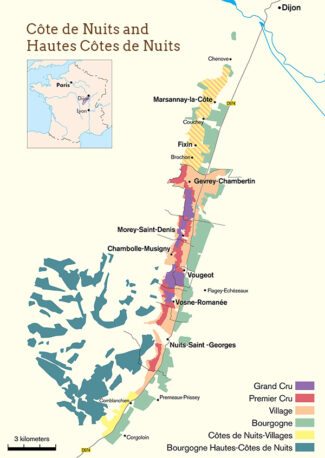
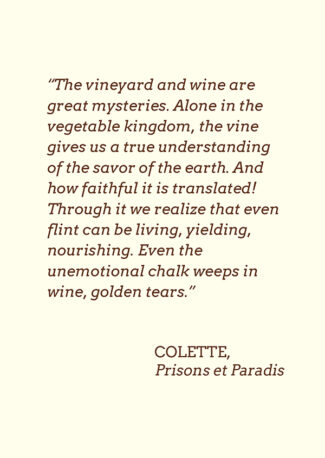
|
|
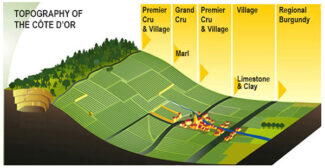
|
|
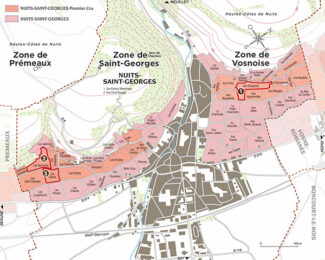
|
|
|
|

|
|
|
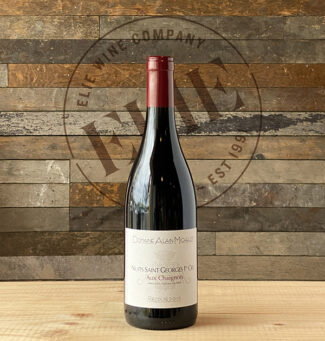 (1) 2015 Nuits-Saint-Georges Premier Cru Aux Chaignots ($102)
(1) 2015 Nuits-Saint-Georges Premier Cru Aux Chaignots ($102)
Aux Chaignots is a fifteen-acre climat that is wonderfully representative of Zone Vosnoise, located at mid-slope with an eastern exposure and overlaying stone and chalk soils. With Les Damodes, Aux Vignerondes and Aux Bousselots Premier Crus as its neighbors, superior drainage encourages a deep root system for the vines to access water and those nutrients that only exist further down in the ground. The vineyard’s exposure works in tandem with its position on the slope, offering plentiful sunlight for ripening throughout the growing season and enough elevation to provide a diurnal temperature variation.
Discreet wood sets off Domaine Alain Michelot’s spicier aromas and enhances the background floral nuances. The mouthfeel is pure and precise with layers of dark cherry, Damson plum and a confit-like finish with wonderful definition and superb length.
|
|
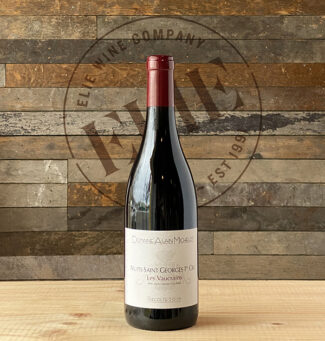 (2) 2015 Nuits-Saint-Georges Premier Cru Les Vaucrains ($110)
(2) 2015 Nuits-Saint-Georges Premier Cru Les Vaucrains ($110)
Les Vaucrains is perhaps the most highly regarded Premier Cru vineyards in the Nuits-Saint-Georges appellation, and in the absence of Grand Cru vineyards, this is considerable praise. A bit more than fifteen acres in size, the climat sit on the steep, upper slope of the Côte d’Or, just below the line on the famous escarpment where vineyard becomes forest. The Premier Cru vineyards of Les Chabœufs and Chaines Carteaux lie to the north and south respectively.
The vineyard’s position means that the soils are calcareous and rocky, as erosion has sent much of the finer material down the hill. The lack of water in the free-draining soil makes for concentrated berries, and a small amount of clay contributes weight to the finished wine, which offers up superb purity and complexity, a mix of red and black cherries, wood smoke above a solid base of soil tones and oak vanilla.
 (3) 2015 Nuits-Saint-Georges Premier Cru Les Cailles ($102)
(3) 2015 Nuits-Saint-Georges Premier Cru Les Cailles ($102)
Les Cailles is a highly-regarded Premier Cru that lies between the Les Saint-Georges and Les Porrets-Saint-Georges climats. Although there are no classified Grand Crus in Nuits-Saint-Georges, this landscape, south of the Nuits-Saint-Georges township and about halfway between there and the neighboring village of Prémeaux-Prissey, is considered by many to be worthy of the status.
The vineyard’s mid-slope position is perfectly angled to take advantage of the morning sunlight; as it rolls gently toward the east, the vines bask in light for a good portion of the day. The soil below is pebbly and sandy, and the climat earns its name from these small stone—‘callou’ is French for pebble.
The wine is explosively precise, with delicate violet petals scents filtering through black cherry and warm raspberry and leading into lithe tannins. The satin texture and a harmonious finish echo dark fruit and smoky spice.
 (4) 2015 Nuits-Saint-Georges ‘Vieilles Vignes’ Village ($75)
(4) 2015 Nuits-Saint-Georges ‘Vieilles Vignes’ Village ($75)
Two vineyard sites supply the grapes for this old vine cuvée, one in the southern part of the village with vines ranging from 65 and 77 years old, and another in Prémeaux-Prissey, where vines were planted fifty years ago.
Complex and rich on nose and palate, the wine shows the exotic qualities of vine age; potent black cherry, sweet black olive tapenade, tart crab apple and strawberry pie between more subtle anise and mint notes, with mature, salty, black licorice notes on the finish.

|
|
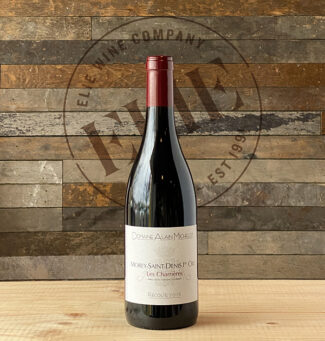 (5) 2015 Morey-Saint-Denis Premier Cru Les Charrières ($93)
(5) 2015 Morey-Saint-Denis Premier Cru Les Charrières ($93)
Les Charrières lies just below the famed Clos de la Roche Grand Cru appellation, and is planted entirely to Pinot Noir. The climat’s east-facing position at the bottom of the slope gives the vines a gentle angle toward the rising sun, helping the vines to develop sugars and phenols in the cool Burgundian climate. Smaller than six acres in size, few wines are made under this designation, which is a shame since the terroir is not dissimilar to its renowned neighbor upstairs. Soils are shallow marly limestone, free draining, encouraging vines to work hard for water reserves and produce high-quality grapes.
Supple and harmonious, the wine is backed by moderately firm tannins supporting black cherry, earth and toasted spice flavors with a developing profile showing truffle, chocolate, rich leather and a silky, lingering and attractively textured finish.
. . . AND ADD
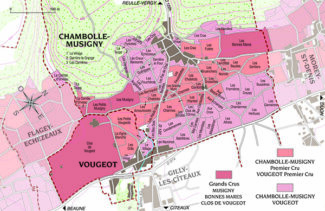
|
|
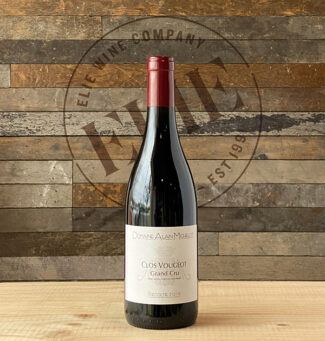 2015 Domaine Alain Michelot Clos Vougeot Grand Cru ($198)
2015 Domaine Alain Michelot Clos Vougeot Grand Cru ($198)
In fact, despite the existence of other Premier Cru sites in the commune of Vougeot, the Clos takes up most of the vineyard space and nearly all the glory, and are in good company: The slopes at the upper end of the Clos abuts the vineyard of Grand Cru Grands Echézeaux.
A Burgundian icon, Clos Vougeot sits 800 feet above sea-level, with its gently-sloping upper reaches consisting of shall soil only a few inches deep; it is coarse-grained and gravelly and lies over a limestone base. In the center portion of the vineyard, soil depth increases, but only slightly, becoming brown with clay and overlaying broken limestone. The lowest portion of the climat contains soil up to two feet deep and is built on layers of marl which are rich in clay and alluvium.
Musky and potent with cherry cordial, wild herbs and smoky minerality, of dark cherry, wild herbs and smoky minerality, the 2015 Domaine Alain Michelot Clos Vougeot is concentrated and sweet, with pronounced soil tones blending within pronounced flavors of underbrush and roasted meat; finishing juicy and very long with finely-grained tannins.
- - -
Posted on 2022.02.14 in Côte de Nuits, Morey-Saint-Denis, France, Burgundy, Wine-Aid Packages | Read more...
‘Rational Exuberance’ in a Dozen Rosés of Champagne and Sparkling Wine
‘Irrational exuberance’ is an economic term referring to speculative bubbles in the stock market. In fact ‘rational exuberance’ can —with equal gusto— also describe the carbon dioxide that puts the sparkle in Champagne bottles. The most painstaking of all winemaking innovations, méthode champenoise made the monks of Saint-Pierre d’Hautvillers see stars, and the wine cosmos has been creating stars ever since—white and rosé.
Regarding this last category, not only are sales of pink Champagne at record levels, it is the only style of Champagne that appears to be recession-proof. To Champagne producers hardest hit by the economic down turn, this style of wine is even more cause for rational exuberance: In today’s market, even basic, non-vintage rosé Champagne tends to sell for more than its white counterparts.
Making Champagne Blush
Getting Champagne to blush relies on one of two unrelated techniques: By far the most common is for chefs de cave simply to mix still white wine with still red wine (Rosé d’Assemblage) before the secondary fermentation. The second method, Saignée (which means ‘to bleed’) rosé, involves bleeding off a portion of red wine juice after it’s been in contact with the skins and seeds. Saignée, often a byproduct of winemaking intended to increase the concentration of red wines; when used in Champagne, it produces wines that tend to be richer in flavor with more pronounced red fruit aromatics, primarily because the allowable red wine grapes in Champagne—Pinot Noir and Pinot Meunier—produce white juice, and that requires more skin contact to pick up color and leads to greater extraction of flavors.
The style of blush Champagne that you ultimately prefer is part of the ‘rational exuberance’ of wine discovery.
Just A Spoonful of Sugar or Not
One of the most easily dispelled misconceptions about rosé Champagne is that, by its nature, it’s a sweet wine. Lo and behold, ‘dosage’ is another Champagne technique that divides the camps. Those in favor believe that the addition of sweetened wine or liquor (in which sugar content is generally measured in grams per liter) as the last step before final corking, is but one of many tools at the disposal of Champagne makers to manipulate the wine’s sensory development. Those opposed to dosage, or ‘liqueur d’expédition’, maintain that no-dosage wines are the purest examples of terroir a sparkling house can offer. Even those chefs de cave who dose choose from a wide variety of options based on the stylistic intentions; up to 50g/l for the ‘doux’ designation to six grams or less for ‘Extra Brut’. Champagne without dosage is often labeled ‘Brut Nature’, which may still contain two or three grams of sugar as part of the natural makeup of the wine.
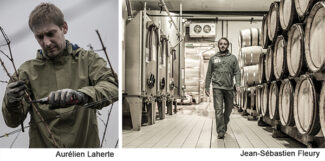
Champagne Laherte Frères
The trend in Champagne is undeniably a move toward the natural, in dosage, in fermentation and in agriculture. At the forefront of this return to the future is Aurélien Laherte. Cresting a wave of dynamic young vignerons, Aurélien founded the ‘Terres et Vins’—a collective of like-minded winemakers in Champagne who have recognized that Champagne is, first and foremost, a wine, and that by using a natural approach to viticulture and winemaking, a new school of ‘vinous Champagne’ could change not only the way the beverage tastes, but the way it is perceived.
Aurélien Laherte comes from a proud heritage of innovation in Chavot, a village on the southern side of the valley formed by the stream Le Cubry. Founded in 1889 by Jean-Baptiste Laherte, Michel and Cécile Laherte (Aurélien’s grandparents) expanded the estate to its current 28 acres. While recognizing that patience is a winemaker’s greatest virtue, Michel and Cécile understood instinctively that the use of herbicides and pesticides prevents full terroir expression in wines, and long before it became trendy, they began working the soils gently, without additives. They passed this philosophy on to their sons Christian and Thierry, and since 2005, when Aurélien (Thierry’s son) took over, he has ensured that these convictions are applied in every phase of the winemaking operation, field to cellar. Today, his portfolio contains a series of tiny production, single-vineyard, single vintage cuvées of around 3,000 bottles each, highlighting some of estates most unique and expressive biodynamically-farmed parcels. These wines are all vinified in Burgundy barrels, without malolactic fermentation, and are bottled without fining and filtration. They are then finished with little or no dosage with the intention of fully exploiting the individuality of the underlying terroirs.
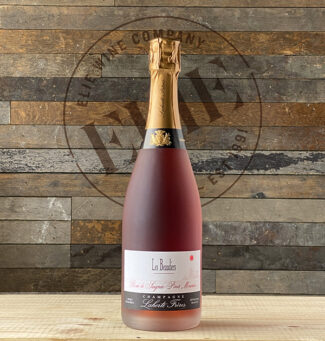 Champagne Laherte Frères ‘Les Beaudiers’, Extra-Brut Rosé ($83)
Champagne Laherte Frères ‘Les Beaudiers’, Extra-Brut Rosé ($83)
The ‘Les Beaudiers’ lieu-dit was planted in 1953, 1958 and 1965, primarily to the low-yielding Pinot Meunier, although there are a few Chardonnay, Pinot Noir and Fromenteau (Pinot Gris) vines in the parcel as well. Soils are predominantly shallow silty clay with silex, limestone and flint above a chalky subsoil. Destemming and maceration of this blend takes place for between 12 and 16 hours, with primary fermentation in used oak, then aged a minimum of 4 years. Dosage is 2 g/l. As a saignée, the color is full-on rose-petal red and offers a rich and expressive nose with a wide range of red fruits: currants, raspberries, and early spring strawberries. (Disgorged April 2021)
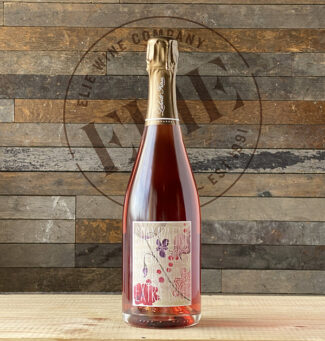 Champagne Laherte Frères ‘Rosé de Meunier’ Extra-Brut Rosé ($58)
Champagne Laherte Frères ‘Rosé de Meunier’ Extra-Brut Rosé ($58)
An innovative cuvée that makes the most of Champagne’s also-ran variety, Meunier. The Laherte plot is made up of Meunier vines between 25 and 40 years old; it is hand-picked at optimal ripeness. 60% is then macerated on the skins, 30% immediately pressed, and 10% of the final blend is still red Meunier. The wine sees a minimum of two years on lees and is dosed at 2.5 g/l; it is persistent, refreshing and precise, racy, and almost peppery, with notes of cranberry, citrus wild cherry, salty plum and dried tarragon. (Disgorged December 2020)
Champagne Fleury
Jean-Sébastien Fleury understands that at its most basic definition, ‘terroir’ means soil: “The key is soil health,” he maintains. ‘We must keep the earth healthy.” As such, at Champagne Fleury, biodynamics is key to the ideology. Many of these practices were pioneered by Jean-Pierre Fleury (Jean-Sébastien’s father), whose interest in sustainable farming began in the 1970s when he tried using manual tilling (as opposed to using herbicides) and composting (as opposed to applying synthetic fertilizers). He began a trial with biodynamics on a few acres, and by 1992, he was using it across the whole of his vineyard holdings. This includes ten plots, a total of forty acres, planted primarily to Pinot Noir. The oldest vines were planted in 1970, and new cuttings are established every year to maintain the vitality that younger vines bring to Champagne.
 Champagne Fleury ‘Rosé de Saignée’, Côte des Bar Brut ($68)
Champagne Fleury ‘Rosé de Saignée’, Côte des Bar Brut ($68)
Located in the southern part of Champagne, the Côte des Bar contains about 20,000 acres planted primarily to Pinot Noir, with about 12% Chardonnay and another four percent of Meunier. ‘Rosé de Saignée’ is 100% Pinot Noir from the Courteron commune—town geographically closer to Chablis than Reims. The nose reveals the pedigree, with Pinot Noir’s characteristic cherry and ripe strawberry tones enveloped in juicy acidity and a mineral-rich finish. (Disgorged January 2021)
Champagne André Clouet
The Clouet family traces its Bouzy roots to 1492 and at one time was the official printmakers for the court of King Louis XV; the classically pretty labels that grace their Champagne bottles today pay homage to their aesthetic history. Clouet grapes are sourced exclusively from 20 acres of coveted mid-slope vineyards in the Grand Cru villages of Bouzy and Ambonnay.
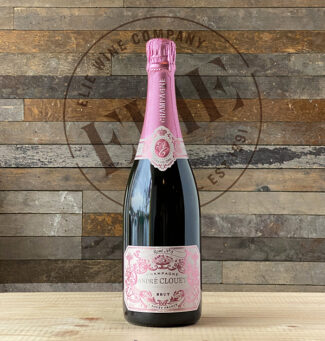 Champagne André Clouet ‘Rosé No. 3’, Grands Crus Bouzy & Ambonnay, Brut ($59)
Champagne André Clouet ‘Rosé No. 3’, Grands Crus Bouzy & Ambonnay, Brut ($59)
A beautiful, salmon-colored, 100% Pinot Noir rosé that picks up its hue and profile from the addition of 8% still Pinot Noir—the ‘3’ represents the style of the wine measured on a scale from 1-10 with 1 being the lightest and 10 being the richest. On this scale a perfect 3 winds up being creamy and full-bodied with raspberry, pomegranate, cherry blossoms on the palate and crushed chalk and orange zest on the finish.
Champagne Pierre Paillard
Paillard is a familiar name to fans of Champagne; Maison Bruno Paillard, the Reims-based producer, was founded in 1981 by Bruno Paillard and financed by the sale of Bruno’s Mark II Jaguar. The Bouzy branch of the family (they are cousins) have been at it a bit longer; Antoine Paillard first bought Bouzy vineyards in 1768. Antoine and Quentin Paillard represent the eighth generation in the family and the fourth generation to produce and bottle Champagne under the family name. The Paillard family vinifies exclusively from its own selection of Pinot Noir and Chardonnay, without a single clone on the estate.
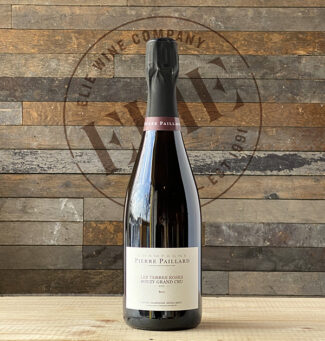 Champagne Pierre Paillard ‘Les Terres Roses XVII’, Grand Cru – Bouzy Extra Brut Rosé ($73)
Champagne Pierre Paillard ‘Les Terres Roses XVII’, Grand Cru – Bouzy Extra Brut Rosé ($73)
A cuvée built upon 65% Chardonnay, 28% Pinot Noir and 7% Bouzy Rouge Pinot Noir. It’s dosed at 2 grams per liter and is quite dry, made 100% from estate-grown fruit from the Grand Cru of Bouzy. Pale grapefruit pink in color, the wine is terroir-focused with less fruit on the nose and more warm brioche, spice, and roasted nut skin. The palate shows lemon and orange peel with leesy undertones. (Disgorged April 2020)
Champagne Gonet-Médeville
By the standards of the region, Gonet-Médeville is ‘new’ Champagne micro-house; it was formed in 2000 by Julie and Xavier Gonet-Médeville as Xavier’s family plots were being divided up. He opted for 30 acres of high quality Premier & Grand Cru vineyards located primarily in the three villages of Bisseuil, Ambonnay, & Mesnil-sur-Oger. The Gonet-Médevilles—sometimes referred to as ‘the first couple of French wines’, also have holdings in five other villages across Champagne.
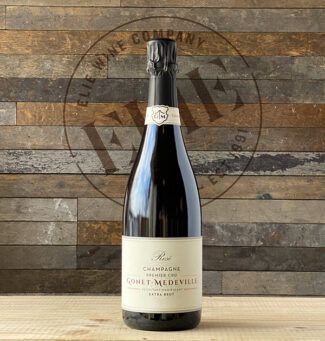 Champagne Gonet-Médeville, Premier Cru Extra Brut Rosé ($86)
Champagne Gonet-Médeville, Premier Cru Extra Brut Rosé ($86)
The cuvée is 70% Chardonnay, 27% Pinot Noir and 3% still Ambonnay Rouge. The wine spends seven months in used barriques and 36 months in bottle without malolactic fermentation, dosed at 3 g/l. The minerality of the Bisseuil and le Mesnil terroirs are at the forefront of this dry, succulent, crisp, peach-toned Champagne; the mousse is delicate, elegant and refreshing. Only 650 cases produced. (Disgorged May 2021)
Champagne JL Vergnon
 Champagne JL Vergnon ‘Rosémotion’, Grand Cru Extra Brut Rosé ($99)
Champagne JL Vergnon ‘Rosémotion’, Grand Cru Extra Brut Rosé ($99)
Don’t let the cute name fool you; this wine—90% Chardonnay, 10% Pinot Noir, with only 2000 bottles produced—is very serious juice. The Chardonnay is sourced from Mesnil-sur-Oger, Oger et Avize and the Pinot Noir from Grand Cru Mailly; 20% of the Chardonnay is aged for three months in oak, while 80% is aged in stainless steel. The wine then spends three years in the cellar, and is dosed at 3 g/l. It shows notes of currants and pomelos in the bouquet, and on the palate, strawberries, saffron and warm biscuits. (Disgorged June 2019)
Champagne Tarlant
Benoît Tarlant and his sister Mélanie are the real deal: With 12 generations of Champagne growers behind them, the current Tarlant estate consists of 35 acres of vines within 31 lieu-dits—half are Pinot Noir, with Chardonnay and Pinot Meunier splitting the difference along with a handful of Champagne’s ‘forgotten grapes’—Pinot Blanc, Arbane and Petit Meslier. Through hands-on experiment and careful observation, Benoît and Mélanie have singled out 63 parcels that they vinify individually after each harvest, allowing them amazing precision in making blending decisions for base and reserve wines, and especially, for highlighting the expressions of single vineyards.
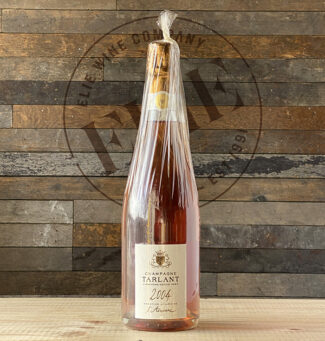 Champagne Tarlant ‘l’Aérienne’, Brut Nature Rosé 2004 ($140)
Champagne Tarlant ‘l’Aérienne’, Brut Nature Rosé 2004 ($140)
50% Chardonnay, 35%, Pinot Noir and 15% Petit Meunier, this bottling comes from four lieu-dits, La Perchape in Œuilly, ‘Four à Chaux, Mont Martin, and Haut du Four à Chaux in Celles-lès-Condé. Each parcel was vinified individually and these four plots were chosen in a blind tasting to be blended and released as a vintage ‘snapshot.’ After aging six months on their lees, the barrels were blended with a small amount of red wine and bottled without dosage on May 4th, 2005. The wine remained sur lattes for 13 years and 9 months before being disgorged on January 31st, 2019. It shows layer upon layer of strawberry pie, brioche and crème brûlée; an excellent balance of fruit and acidity with persistent cream undertones complemented by a driven finish. (Disgorged January 2019)
Champagne Philipponnat
Philipponnat is one of the last remaining Champagne houses run by an original family member, and Charles Philipponnat proudly calls himself ‘a true Champenois, descended from winemakers, cellar masters and growers dating back nearly 600 years.’ For the record, his father René was chef de caves at Moët from 1949 to 1977, responsible for 1961 Dom Pérignon. Since taking over in 1999, Charles has remained hell-bent on returning Philipponnat to its last Golden Age, 1913-1962, when Louis Boland was chef de caves. He has gradually increased the amount of wine aged in neutral wood, and to maximize character, his non-vintage wines age for three years en tirage, while the vintage cuvées spend from five to 10 years on the lees.
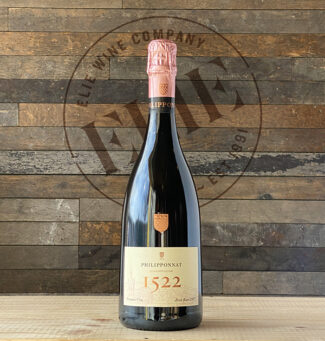 Champagne Philipponnat ‘1522’, Premier Cru Rosé 2007 ($180)
Champagne Philipponnat ‘1522’, Premier Cru Rosé 2007 ($180)
70% Pinot Noir and 30% Chardonnay, with the Pinot Noir coming from the Léon vineyard in Ay and the Chardonnay from Mesnil-sur-Oger. A silky-textured gem loaded with dried herbs, fresh mint, almond butter and smoky black tea as savory notes, and with a dosage of 4.25 g/l, the fruit notes are white peach, apple, grapefruit and lime. (Disgorged June 2016)

Raventós i Blanc
The Raventós family considers itself a winegrowing dynasty, and with considerable justification: 21 generations have lived on their 222-acre estate since 1497, making them among the oldest winegrowing families in the world. Today, biodynamic grower Pepe Raventós farms 44 individual plots, making the most of an ideal microclimate influenced by rivers, lakes, streams and perhaps most notably, the terraces planted on the hill known as the Turó del Serral.
 Raventós i Blanc ‘de Nit’ Barcelona Espumoso 2018 Rosé ($27)
Raventós i Blanc ‘de Nit’ Barcelona Espumoso 2018 Rosé ($27)
“Looking for color, I found Monastrell from the western part of the Serral hill, which provides complexity without losing freshness,” says Pepe Raventós, using the Catalan word for Mourvèdre. ‘De Nit’ is Catalan for ‘the night’, and this wonderfully affordably, top-shelf Espumoso rosé also includes judicious amounts of Xarel-lo, Macabeu and Parellada, whose vines were planted between 1969 and 2000. (Disgorged September 2021)
De Nit 2018 en Jeroboam
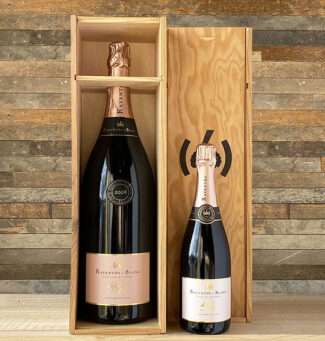 Raventos i Blanc ‘de Nit’ Barcelona Espumoso2018 Rosé ($130)
Raventos i Blanc ‘de Nit’ Barcelona Espumoso2018 Rosé ($130)
What is four times better than three-quarter liter bottle of ‘de Nit’? Three liters of the same. (Disgorged September 2021)
Can Sumoi
At two thousand feet above sea level in the Serra de l’Home range, Can Sumoi is the highest estate in the Penedès and represents a collaboration between two childhood pals, Pepe Raventós and Francesc Escala. The 350-year-old farmhouse that is the focal point of the estate sits above 75 acres planted to Montonega, Xarel-lo and Sumoll vines.
 Can Sumoi ‘Ancestral Sumoll’ Rosé Brut Nature 2018 ($28)
Can Sumoi ‘Ancestral Sumoll’ Rosé Brut Nature 2018 ($28)
The name ‘Sumoll’ has roots in the Latin word ‘submolliare’ which means ‘to wither’, perhaps in reference to Sumoll’s use in producing high-end straw wines. Here, this 100% Sumoll occupies the opposite end of the wine spectrum as straw wine; it is a bone-dry, lightly floral sparkler with fresh black fruit aromas accented by saltiness and toasted almond notes. * Don’t expect a Champagne-ferocious fizz; rather than using Méthode Champenoise, ‘Ancestral Sumoll’ is partially fermented in stainless steel vats with fermentation completed inside the bottle, resulting in gentler effervescence. (Disgorged June 2020)
- - -
Posted on 2022.02.06 in France, Champagne | Read more...
The Grape Variety That Came in From the Cold: Rioja’s Graciano Vine is at Home, and Soars, in La Mancha. Natural-ly. (3 Wines in a 6-Bottle Pack for $196)
Graciano in Rioja: But Never the Bride
Avis Car Rental changed advertising history by touting the virtues of playing second fiddle. ‘Always a bridesmaid, never a bride’ is a clichéd acknowledgment of a supporting role. But Graciano, a Spanish grape variety traditionally used to add complexity to Tempranillo-based Rioja, has found a new generation of suitors prepared to take her all the way to the altar.
Climate change plays a role in the Graciano’s status as a rising star. A late-budding grape, Graciano is also late-ripening, often the last variety to be harvested. With warmer growing seasons, longer hang-times and subsequent phenolic ripeness is achieved, allowing the grapes to express more mature tannins and a wider array of flavors.
Producers in Rioja (and beyond, in La Mancha) are now taking advantage of the phenomenon by paying more attention to Graciano’s potential as a stand-alone varietal wine. Its natural resistance to mildew makes it attractive to organic growers, and despite generally low yields compared to Tempranillo, it remains the brightest understudy in Spain.

Uva de Vida
Where Graciano is Center Stage
“If we take care of the earth, we take care of ourselves,” promises Maria Carmen López Delgado. “Life has given me a new opportunity.”
She is alluding to the sudden illness and prolonged recovery that refocused her cosmic viewpoint and convinced her that her personal renewal could be mirrored in the ways she tended a vineyard. “We made this decision when my illness pushed us to look for everything related to living and life in seeking to recover health.”
In 2005, with her partner Luis Ruiz, she pioneered biodynamic agriculture and winemaking throughout a 20-acre vineyard in Santa Olalla near Toledo. The dry continental climate of central Spain was ideal for the cultivation of Graciano, of which she planted twelve acres compared to five of Tempranillo. That alone makes her iconic; Graciano is rare enough in Spain, let alone among the cereal fields and Cornicabra olive groves of Castilla-La Mancha.
 Delgado’s spiritual journey in both life and viniculture is reflected in the Mandala symbol that appears on her labels; it mirrors the geometric layout of her vineyards. The eight-pointed star references Toledo’s Arabic and Jewish past as well as illustrating the tenuous, if stable balance between spirit and matter. It is part of a larger movement in winemaking that stresses an irreplaceable symbiosis of the grower and the vineyard.
Delgado’s spiritual journey in both life and viniculture is reflected in the Mandala symbol that appears on her labels; it mirrors the geometric layout of her vineyards. The eight-pointed star references Toledo’s Arabic and Jewish past as well as illustrating the tenuous, if stable balance between spirit and matter. It is part of a larger movement in winemaking that stresses an irreplaceable symbiosis of the grower and the vineyard.
Channeling the correct energy is as vital to Delgado’s philosophy as is her stand against artificial preservatives in food and wine: “These substances are harmful to people’s health, sulfites especially; they are toxic and, for wine, they are an atomic bomb.” Her dedication has been noted: Uva de Vida is one of the few Spanish members of the prestigious biodynamic association ‘La Renaissance des Appellations’ to which only 175 wine growers worldwide belong.
The Biodynamic Principles: Spirituality and the Force of Nature
Says Maria Carmen López Delgado: “We think that biodynamics is the means to achieve in the vineyard a self-regulated ecosystem, independent and free of all chemistry. Biodynamics is a path of knowledge. To know our culture, the soil, the climate… to know oneself.” This implies a special connection between the person and the vineyard.
Walking the walk as well as she talks it, she maintains that she and Luis are ‘spectators’ accompanying the natural process of vine tending and fermentation. This allows them to take into account the lunar calendar when they plan racking and bottling while adhering to agricultural ‘hands-off’ means more flora and fauna exist in the vineyard.
“In biodynamics there are no recipes,” Delgado insists. “Biodynamics is an impulse, an understanding, an inspiration. It entails a result, but the result is not the end: Each year, we interpret what we believe the vineyard needs so as not to distort its relationship with the environment and then we allow nature express itself with total freedom. Biodynamic preparations activate the processes of life; the basis of biodynamics is to invigorate the soil, but the most important thing is the intention of the person, the imprint, the imprint. Even the thoughts of people are capable of generating living forces.”
The special offer includes two bottles of each of the following three wines: Septenio, Latitud 40 and Biográfico, for a total of six bottles pack for $196.
 ‘Septenio’ 2012 (Vino de España) ($54)
‘Septenio’ 2012 (Vino de España) ($54)
100% Graciano from the estates prized northeast and southeast facing slopes, where grapevines share its sun-drenched clay-limestone terroir with olive trees and grain. Entirely hand-harvested, Delgado allows a four-day maceration before natural fermentation in stainless steel. After pressing, the wine spent two years in used French oak, and prior to being bottled in 2016, it was topped off with a percentage of younger wine from 2013, 2014 and 2015, giving it a complex, multi-dimensional profile. Luxardo cherries, black currants and orange peel notes are lined with spicy wood accents and fresh tobacco leaf. Only 1,664 bottles produced.
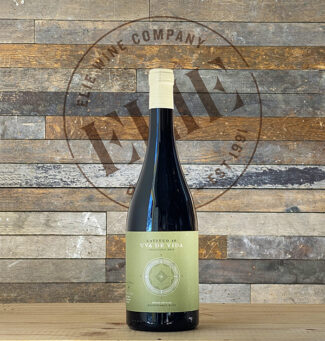 ‘Latitud 40’ 2018 (Vino de la Tierra de Castilla) ($24)
‘Latitud 40’ 2018 (Vino de la Tierra de Castilla) ($24)
Uva de Vida winery sits at the wine-friendly 40˚ northern latitude, which circumvents the globe to include northern California, Sardinia and about half of the wine producing areas in China. Here, forty miles south of Madrid, it suits Graciano—the sole varietal used here. Although the ‘Vino de la Tierra de Castilla’ designation carries with it slightly less stringent regulations that the prestigious DOs of Castilla-La Mancha, like the ‘Super Tuscans’, gems may be found among the iconoclasts. Ideally served slightly chilled, ‘Latitud 40’ displays freshness on the nose with hints of lilac, menthol and pie cherries. On the palate, wild blueberries take center stage and the menthol shows a mint-leaf edge. The finish is long and juicy with a slight hint of chocolate. 20,000 bottles made.
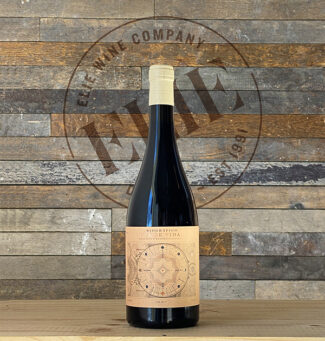 ‘Biográfico’ 2018 (Vino de la Tierra de Castilla) ($20)
‘Biográfico’ 2018 (Vino de la Tierra de Castilla) ($20)
The 2018 version of this vibrant wine contains a 50/50 blend of Tempranillo and Graciano grown in clay-limestone soils at an altitude of about 1600 feet. Hand-harvested and fermented on ambient yeasts, the wine is clarified naturally and bottled unfiltered without sulphur. The dark color belies a lyrical, almost floral quality to the wine; lilac and violet notes appear on the nose, with bright, spicy red fruit supplied by the Graciano tempered with the earthy tannins of Tempranillo. 8,800 bottles produced.
Other limited cuvées available from Uva de Vida ….
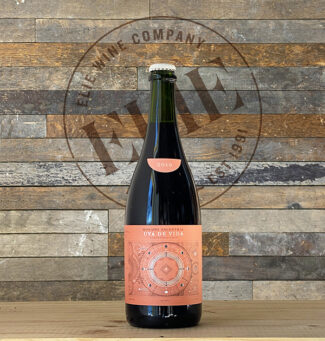 ‘Rosado Ancestral’ 2019 (Vino de la Tierra de Castilla) ($31) The 2019 Rosado Ancestral is 100% Tempranillo, the product of the youngest vines in Delgado’s Santa Olalla property. It is produced by allowing only minimal skin contact with red grapes; it is intended to be a light, fresh, chillable rosado—the Spanish version of rosé. A pretty nose of rose petals, fresh almonds and wild strawberries and a palate of succulent acidity that balances the impression of sweetness. 1700 bottles made.
‘Rosado Ancestral’ 2019 (Vino de la Tierra de Castilla) ($31) The 2019 Rosado Ancestral is 100% Tempranillo, the product of the youngest vines in Delgado’s Santa Olalla property. It is produced by allowing only minimal skin contact with red grapes; it is intended to be a light, fresh, chillable rosado—the Spanish version of rosé. A pretty nose of rose petals, fresh almonds and wild strawberries and a palate of succulent acidity that balances the impression of sweetness. 1700 bottles made.
 ‘Esencia Oxidativa’ 2012 (Vino de España) ($39) An extremely rare beast; only 157 bottles made, and they are 500 ml. at that. Oxidation is a process familiar to lovers of dry-aged Spanish sausages and salamis, wherein the producer sacrifices a bit the original item to yield a more complex and fulfilling final product. In meat, this is done by stressing the original stock with exposure to oxygen to provoke its best traits to come forward in defense. This is also done with wine, most notably in Jerez with sherry. Uva de Vida has produced this effect with the 100% Graciano ‘Esencia Oxidativa,’ harvested and vinified with the same biodynamic intensity of the rest of the wines from this estate, it underwent exposure to oxidation over many years in used 225 liter oak barrels. The finished wine is 16% alcohol and shares characteristics with the classic Oloroso Sherry of Jerez, but in a red-wine package; nutty, yeasty, and filled with the unique quality know to gastronomes as ‘umami’. In fact, this is due to the increase of glutamate produced when wine interacts with air.
‘Esencia Oxidativa’ 2012 (Vino de España) ($39) An extremely rare beast; only 157 bottles made, and they are 500 ml. at that. Oxidation is a process familiar to lovers of dry-aged Spanish sausages and salamis, wherein the producer sacrifices a bit the original item to yield a more complex and fulfilling final product. In meat, this is done by stressing the original stock with exposure to oxygen to provoke its best traits to come forward in defense. This is also done with wine, most notably in Jerez with sherry. Uva de Vida has produced this effect with the 100% Graciano ‘Esencia Oxidativa,’ harvested and vinified with the same biodynamic intensity of the rest of the wines from this estate, it underwent exposure to oxidation over many years in used 225 liter oak barrels. The finished wine is 16% alcohol and shares characteristics with the classic Oloroso Sherry of Jerez, but in a red-wine package; nutty, yeasty, and filled with the unique quality know to gastronomes as ‘umami’. In fact, this is due to the increase of glutamate produced when wine interacts with air.
The Gesture of Being ‘Natural’: Low Intervention or ‘Raw’
In wine, ‘natural’ is a concept before it’s a style. It refers to a philosophy; an attitude. It may involve a regimen of rituals or it may be as simple as a gesture, but the goal, in nearly every case, is the purest expression of fruit that a winemaker, working within a given vineyard, can fashion. Not all ‘natural’ wines are created equal, and some are clearly better than others, but of course, neither is every estate the same, nor every soil type, nor each individual vigneron’s ideology.
The theory is sound: To reveal the most honest nuances in a grape’s nature, especially when reared in a specific environment, the less intervention used, the better. If flaws arise in the final product—off-flavors, rogue, or ‘stuck’ fermentation (when nature takes its course), it may often be laid at the door of inexperience. Natural wine purists often claim that this technique is ancient and that making wine without preservatives is the historical precedent. That’s not entirely true, of course; using sulfites to kill bacteria or errant yeast strains dates to the 8th century BCE. What is fact, however, is that some ‘natural’ wines are wonderful and others are not, and that the most successful arise from an overall organoleptic perspective may be those better called ‘low-intervention’ wine, or ‘raw’ wine—terminology now adopted by many vignerons and sommeliers.
At its most dogmatic and (arguably) most OCD, natural wines come from vineyards not sprayed with pesticides or herbicides, where the grapes are picked by hand and fermented with native yeast; they are fined via gravity and use no additives to preserve or shore up flavor, including sugar and sulfites. Winemakers who prefer to eliminate the very real risk of contaminating an entire harvest may use small amounts of sulfites to preserve and stabilize (10 to 35 parts per million) and in natural wine circles, this is generally considered an acceptable amount, especially if the estate maintains a biodynamic approach to vineyard management.
In all things wine, ‘balance’ is a key to the kingdom; it is a term interchangeable with harmony, and may reference acid, alcohol level, grape sugars and tannin, but also, to a scale in which the long-term health of the product is considered along with the flavors inherent on release. More than just a current radar blip in trendy social capital a naturalistic approach to winemaking is not only more honest, but better for a sustainable environment: It’s a nod to the past and a gesture to the future.
Decoding the Label
Vinos de La Tierra V.T. (Indicación Geográfica Protegida I.G.P.) and Denominación de Origen D.O. (Denominación de Origen Protegida D.O.P.)
At Elie’s, our specialties include highly-allocated, top-tier D.O.P. (Denominación de Origen Protegida) Spanish wines, but we are always on the lookout for spectacular values regardless of label. This week’s package includes a number of wines designated Vinos de La Tierra V.T. (Indicación Geográfica Protegida I.G.P.).
A word on the difference: A specific D.O.P is governed by a ‘consejo regulador’, which decides on the boundaries of the region, allowed varietals, maximum yields, limits of alcoholic strength and similar standards and limitations; as of 2019 there are 96 DOPs in Spain. V.T. wines, and there are 46 demarcated production areas (see above map), follow rules that are slightly less stringent, allowing a winemaker greater freedom to experiment, especially with grape varieties. VT wines are most assuredly high-quality, single-estate wines that may, in all other quality measures, be identical to D.O.P. wines—a rung down the designation ladder in name alone.
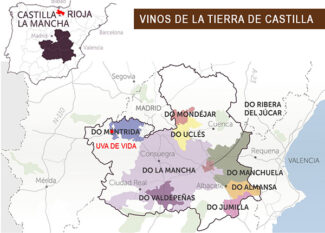
- - -
Posted on in France, Spain DO, Wine-Aid Packages | Read more...
Featured Wines
- Notebook: A’Boudt Town
- Saturday Sips Wines
- Saturday Sips Review Club
- The Champagne Society
- Wine-Aid Packages
Wine Regions
Grape Varieties
Aglianico, Albarino, Albarín Tinto, Alicante Bouschet, Aligote, Altesse, Arbanne, Arcos, Auxerrois, Barbarossa, Beaune, Biancu Gentile, Bonarda, bourboulenc, Cabernet Sauvignon, Calvi, Carcajolu-Neru, Chenin Blanc, Cinsault, Clairette, Cortese, Corvinone, Cot, Counoise, Dolcetto, Erbamat, Fiano, folle Blanche, Fumin, Gamay, Garganega, Garnacha Tintorera, Godello, Graciano, Grenache, Grenache Blanc, Grolleau, Groppello, Jacquère, Juan Garcia, Lladoner Pelut, Macabeo, Maconnais, Malbec, Malvasia, manseng, Marcelan, Marsanne, Marselan, Marzemino, Melon de Bourgogne, Mencía, Merlot, Montepulciano, Montònega, Moscatell, Mourv, Mourvèdre, Muscadelle, Muscat, Natural, Nebbiolo, Nero d'Avola, Niellucciu, Palomino, Parellada, Patrimonio, Pecorino, Pedro Ximénez, Persan, Petit Meslier, Pineau d'Aunis, Pinot Auxerrois, Pinot Blanc, Pinot Gris, Pinot Meunier, Pinot Noir, Pouilly Fuisse, Pouilly Loche, Riesling, Rousanne, Sagrantino, Sangiovese, Sauvignon, Sciacarellu, Semillon, Serine, Sumoll, Tempranillo, Teroldego, Timorasso, Trebbiano Valtenesi, Treixadura, trepat, Trousseau, Ugni Blanc, Vermentino, Viognier, Viura, Xarel-loWines & Events by Date
- September 2025
- August 2025
- July 2025
- June 2025
- May 2025
- April 2025
- March 2025
- February 2025
- January 2025
- December 2024
- November 2024
- October 2024
- September 2024
- August 2024
- July 2024
- June 2024
- May 2024
- April 2024
- March 2024
- February 2024
- January 2024
- December 2023
- November 2023
- October 2023
- September 2023
- August 2023
- July 2023
- June 2023
- May 2023
- April 2023
- March 2023
- February 2023
- January 2023
- December 2022
- November 2022
- October 2022
- September 2022
- August 2022
- July 2022
- June 2022
- May 2022
- April 2022
- March 2022
- February 2022
- January 2022
- December 2021
- November 2021
- October 2021
- September 2021
- August 2021
- July 2021
- June 2021
- May 2021
- April 2021
- March 2021
- February 2021
- January 2021
- December 2020
- November 2020
- October 2020
- September 2020
- August 2020
- July 2020
- June 2020
- May 2020
- April 2020
- March 2020
- February 2020
- January 2020
- December 2019
- November 2019
- October 2019
- September 2019
- August 2019
- July 2019
- June 2019
- May 2019
- April 2019
- March 2019
- February 2019
- January 2019
- December 2018
- November 2018
- October 2018
- September 2018
- August 2018
- July 2018
- June 2018
- May 2018
- April 2018
- March 2018
- February 2018
- January 2018
- December 2017
- November 2017
- October 2017
- September 2017
- August 2017
- July 2017
- June 2017
- May 2017
- April 2017
- March 2017
- February 2017
- January 2017
- December 2016
- November 2016
- October 2016
- September 2016
- August 2016
- July 2016
- June 2016
- May 2016
- April 2016
- March 2016
- February 2016
- January 2016
- December 2015
- November 2015
- October 2015
- September 2015
- August 2015
- July 2015
- June 2015
- May 2015
- April 2015
- March 2015
- February 2015
- January 2015
- December 2014
- November 2014
- October 2014
- September 2014
- August 2014
- July 2014
- June 2014
- April 2014
- March 2014
- February 2014
- January 2014
- December 2013
- November 2013
- October 2013
- September 2013
- August 2013
- July 2013
- June 2013
- May 2013
- April 2013
- March 2013
- February 2013
- January 2013
- December 2012
- November 2012
- October 2012

